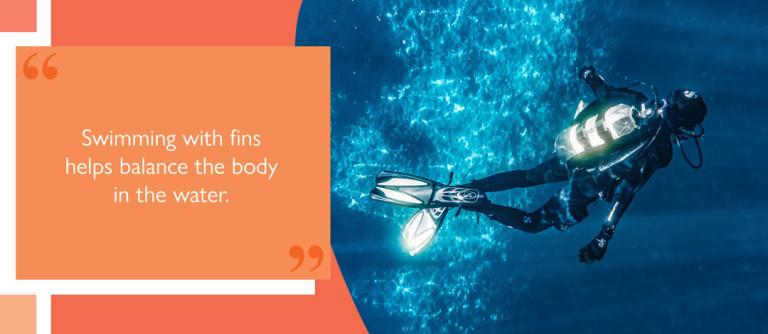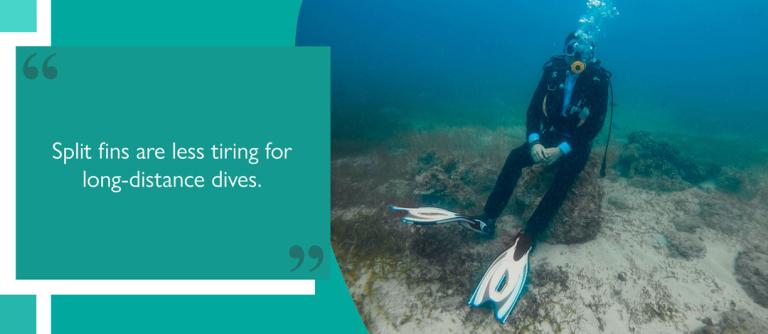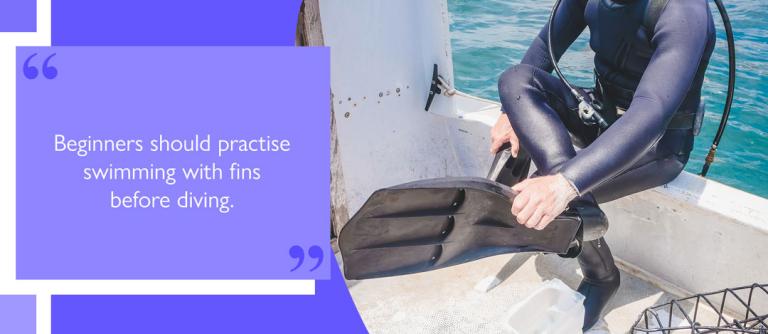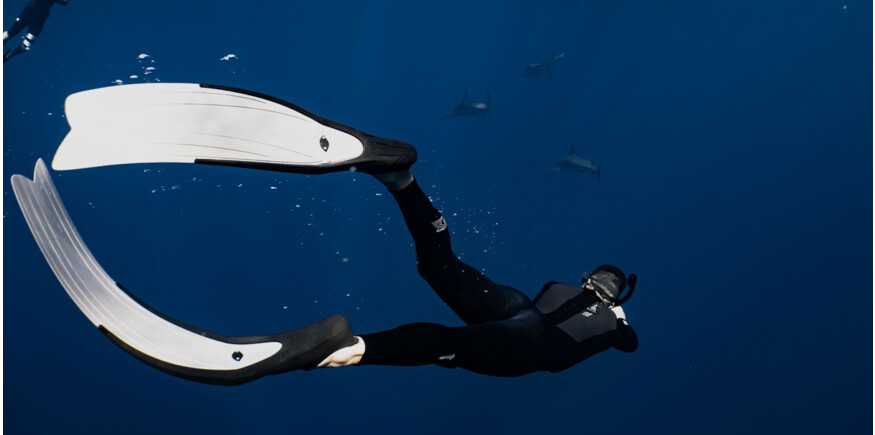From surface snorkelling to freediving – the additional thrust provided by flippers is invaluable for underwater swimming. Without them, divers consume more energy and oxygen, shortening dive time.
While some divers may prefer one term over another, ‘flippers’ and ‘fins’ are generally used interchangeably.


How diving flippers work
Diving fins are designed to mimic webbing on the feet of aquatic animals like frogs and ducks. The broad surface of a fin displaces water and generates thrust, propelling the diver forward.
The design allows divers to move faster and cover greater distances. Swimming with fins means less energy is consumed, endurance improves, and air supply is conserved.
Flippers also help balance the body in the water, allowing for more efficient swimming technique. This reduces the pressure on core and upper body muscles, and makes fatigue or injury less likely.
Types of diving fins
Differences between blades – be that size, flexibility, or shape – have a significant impact on performance.
Longer fins generally provide more efficient thrust. However, the design needs to strike a balance between flexibility and stiffness so that kick strokes don’t sap too much energy.
Paddle fins
Powerful and able to be made as rigid or flexible as required, paddle fins (aka ‘blade’ fins) vary in shape and size. For example, fins designed for snorkelling or shallow surface dives often have short, stiff blades to boost each kick.
If a fin blade is too flexible it will be inefficient when swimming underwater. If it is too rigid, energy will be wasted on each upward stroke as the lack of give will create more resistance. Both extremes are ineffective, resulting in more air being used, and increasing the chance of fatigue.


Split fins
Split fins are less tiring for long-distance dives. The split in the fin helps displace more water on each stroke, generating additional propulsion while expending less energy.
Designed to mimic a fish tail, the split fin generates bursts of thrust over short distances. They’re suited to divers of all abilities. However, divers accustomed to encountering resistance when wearing non-split dive fins may need a period of adjustment to get used to them.
Freediving fins
Fins for freediving tend to be on the longer side. The length helps generate more thrust per stroke, allowing the diver to cover more distance.
Although they are longer, freediving blades should not be too stiff. Having a bit of ‘give’ allows for a ‘snap’ in each kick. This quickly scoops and displaces water, granting a speed boost.
A blade that is too rigid will be unable to provide the snapping motion needed to scoop water, making them more tiring to use.
Scuba diving fins
While not as long as freediving flippers, scuba diving fins are usually longer and wider than snorkelling fins. The larger surface area generates more thrust, even on slow kicks, allowing a diver to conserve energy.
Long, bulky fins propel better but make manoeuvring a bit more challenging. This is an important consideration in more technical dives, or for activities such as cave diving.


Full foot diving fins
Full foot fins are worn without boots. They have a flexible pocket to cover and hold the foot. Because they are worn barefoot, these fins are better suited to warm water dives.
For dives in cold water, open heel fins can be worn with thick neoprene boots and a diving wetsuit to keep the body insulated.
Thin neoprene socks can be worn with full foot fins for additional comfort and warmth. Try the fins on with aqua socks before diving to ensure a secure and comfortable fit.
Sourcing high-quality diving gear
Find the perfect diving fins for your underwater adventures with Two Bare Feet. We offer a variety of sizes, shapes, and designs for adults, children, and a range of subaquatic activities.
You can also get all you need with one of our three-piece silicon diving gear sets, containing a mask, snorkel, and fins. Check out our range of changing robes to make getting in and out of your gear more comfortable, especially on those cold days.
We also stock a selection of well-made and reliable wetsuits of varying thicknesses, along with neoprene wetsuit accessories such as boots, socks, gloves, and wetsuit hoods.




